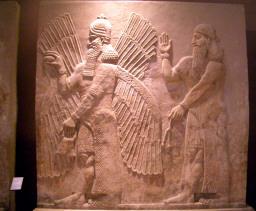Scholars worldwide are now able to study precious cuneiform tablets preserved in the National Museum of Iraq thanks to a new Italian-run project to create copies of the fragile clay blocks, researchers said Wednesday.
The Baghdad museum holds a rich collection of artefacts bearing inscriptions in cuneiform - the wedge-shaped form of writing invented by the Sumerians 5,000 years ago - but it has been closed to the public after being looted in 2003 during the US-led invasion of Iraq.
The new project run by Pisa University's Assyriology Department and the Italian Agency for New Technologies, Energy and the Environment (ENEA), will mean historians and archaeologists can examine perfect copies of the tablets and other cuneiform inscriptions held in the museum from afar.
ENEA researcher Paola Negri explained that the 'Duplication and Rebirth' project can create both virtual and physical reproductions of the relics using a technique called rapid prototyping, which is used in hospitals to create prosthetic limbs and in reconstructive surgery.
The technique allows researchers to faithfully reconstruct artefacts without handling them too much and without moving them from the museum.
The object is first scanned by a laser ray, which transfers an image onto a computer in thin horizontal cross-sections. This image is then used in the rapid prototyping method, which builds up layers of thermoplastic material to recreate a perfect copy of the original.
Negri said the technique was particularly useful for the delicate clay tablets, which are the same size as a pack of cigarettes and have cuneiform inscriptions on the front, back and sides. The method also means that it will be possible to construct tailor-made containers for the tablets and other archaeological relics in the event that they ever need to be moved, Negri added.
''The union of technology and archaeology in the cataloguing and virtual reproduction of the relics in the Baghdad museum is particularly important because it allows for the safekeeping of the cultural, historical and archaeological heritage of Iraq despite the impossibility of working directly in the territory,'' said Negri.
She also said the technique, being used for the first time in Iraq, will be useful elsewhere in the world to make copies of museum pieces too delicate to be moved. Present-day Iraq lies on the site of ancient Mesopotamia between the Tigris and Euphrates rivers and the Baghdad museum boasts one of the best collections of ancient artefacts in the world.
Around 15,000 of the museum's relics were carried off during a 48-hour looting spree in 2003 in the wake of the US invasion.
Denounced as the most catastrophic theft of antiquities since World War II, the plundering sparked international outrage and condemnation of America for failing to prevent the thefts.
Italian art cops, who are some of the best in the world, were enlisted in the race to track down the looted treasures.
Thousands of relics have since been found and returned, many from abroad, but many are still missing.
The police believe many of the treasures found their way to a collection centre for smuggled Iraqi artefacts which has contacts with interested buyers, particularly in Britain, Switzerland and the United States.
The Italian Culture Ministry has funded restoration on the museum's Assyrian and Islamic antiquity galleries, which mainly contain relics too big to be at risk of further looting, and work should be finished before the summer.
The museum is working on a way to open these two sections to the public, but said the current security system is inadequate and it is afraid that it will become a target for bombers.













